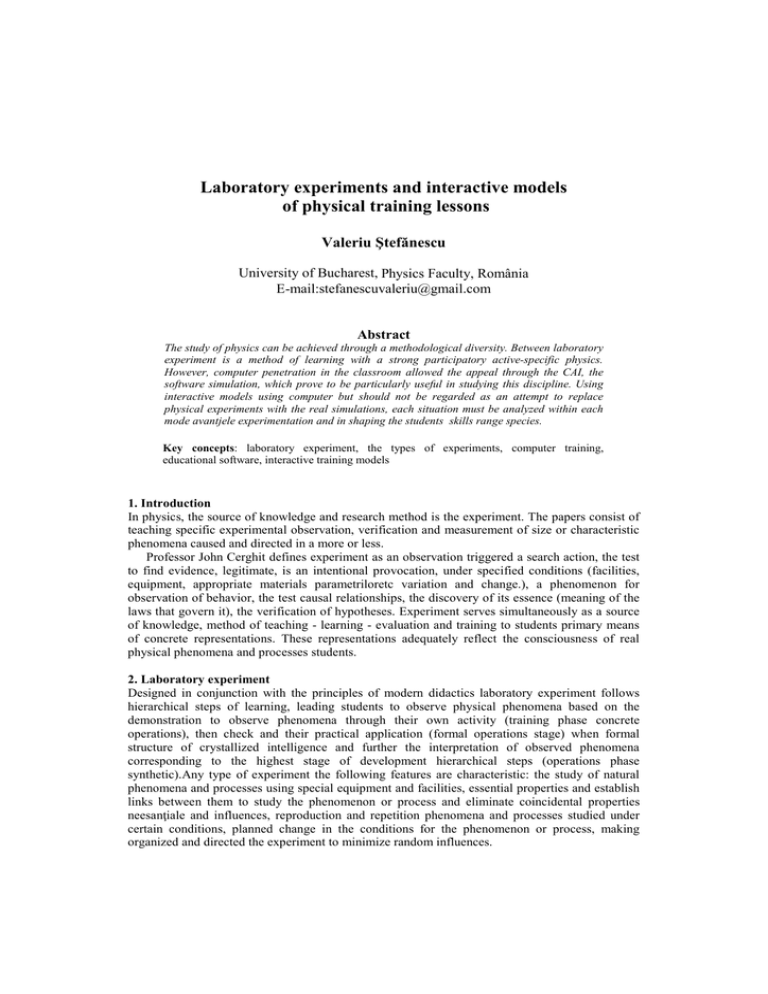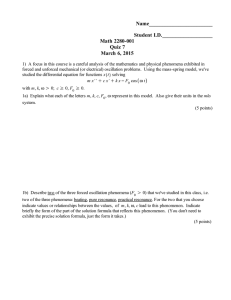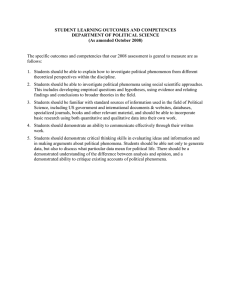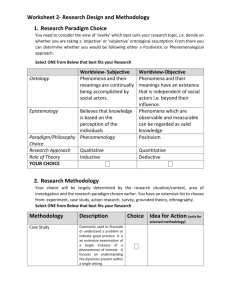View Paper
advertisement

Laboratory experiments and interactive models of physical training lessons Valeriu Ştefănescu University of Bucharest, Physics Faculty, România E-mail:stefanescuvaleriu@gmail.com Abstract The study of physics can be achieved through a methodological diversity. Between laboratory experiment is a method of learning with a strong participatory active-specific physics. However, computer penetration in the classroom allowed the appeal through the CAI, the software simulation, which prove to be particularly useful in studying this discipline. Using interactive models using computer but should not be regarded as an attempt to replace physical experiments with the real simulations, each situation must be analyzed within each mode avantjele experimentation and in shaping the students skills range species. Key concepts: laboratory experiment, the types of experiments, computer training, educational software, interactive training models 1. Introduction In physics, the source of knowledge and research method is the experiment. The papers consist of teaching specific experimental observation, verification and measurement of size or characteristic phenomena caused and directed in a more or less. Professor John Cerghit defines experiment as an observation triggered a search action, the test to find evidence, legitimate, is an intentional provocation, under specified conditions (facilities, equipment, appropriate materials parametriloretc variation and change.), a phenomenon for observation of behavior, the test causal relationships, the discovery of its essence (meaning of the laws that govern it), the verification of hypotheses. Experiment serves simultaneously as a source of knowledge, method of teaching - learning - evaluation and training to students primary means of concrete representations. These representations adequately reflect the consciousness of real physical phenomena and processes students. 2. Laboratory experiment Designed in conjunction with the principles of modern didactics laboratory experiment follows hierarchical steps of learning, leading students to observe physical phenomena based on the demonstration to observe phenomena through their own activity (training phase concrete operations), then check and their practical application (formal operations stage) when formal structure of crystallized intelligence and further the interpretation of observed phenomena corresponding to the highest stage of development hierarchical steps (operations phase synthetic).Any type of experiment the following features are characteristic: the study of natural phenomena and processes using special equipment and facilities, essential properties and establish links between them to study the phenomenon or process and eliminate coincidental properties neesanţiale and influences, reproduction and repetition phenomena and processes studied under certain conditions, planned change in the conditions for the phenomenon or process, making organized and directed the experiment to minimize random influences. 336 University of Bucharest and "Babeş-Bolyai" University of Cluj-Napoca Stages of the procedure include: creating a justification (reasons), making a problem (to serve as a system of thought), analysis and formulation of hypotheses, development of experimental strategies based on existing equipment, conduct the actual experiment, organization and observation, discussion of procedures used, data processing and drawing conclusions (a temporary solution), verifying the results (findings), through practical application and validity and significance discovery conclusions (Cerghit, I., 2001, pg.76). The experiment has a great formative value because students develop a sense of observation, investigation, ability to understand the essence of objects and phenomena, processing and interpretation of experimental data, etc. stimulate interest in knowledge. Experiments can be classified according to several criteria. From an organizational perspective, we distinguish experimental work carried out: individual (separate topics or not, each student working independently, provided with all necessary technical and material conditions) in groups (2-3 students) when you do not have enough equipment and installations or intentional, especially, to train the students with teamwork and combined forms or front - experiment is carried out by each student, while at the same pace, on the same subject, under the direction of teacher, provided that can provide equipment, materials, facilities for each pupil. However, in practice we distinguish school: experimental demonstration, prepared by the teacher before the lesson and subsequently Vedra class demonstration, explanation, confirmation or verification of facts specifying; experiment applied, used to verify the possibilities their students in practice teroetice acquired knowledge, skills training for the experiment, the driving skills of handling laboratory equipment. Computer use and application of new technology-based teaching strategies in educational activities contribute to the development of forms of organization of training not possible using the methods and traditional means. Possibilities of computer processing, recording and retrieval of information triggers the situations in which the student acquires knowledge and skills independently, in accordance with the interests and aspirations. Computer Aided involves direct intervention in the organization of computer learning situation through an educational software. Field studies show that using computers in practical work and laboratory learning efficiency increases by about 30%. 3. Models of physical training lessons Educational software is a program designed for use in teaching - learning - assessment as a means of interactive learning, providing opportunities for individualization. It is made according to certain educational requirements (specific content, target group characteristics, behavioral objectives) and certain technical requirements (preparation of individual interactions, feedback and formative assessment sequence). After the priority function that can meet the training process can be divided into educational software: software interactive software to exercise (Drill and Practice), simulation software, computer models of laboratory work, theme software, software testing / evaluation of knowledge, software tools, educational games. Simulation software (interactive models) allow students to observe the monitor screen representation of a controlled trial or a real phenomenon, based on a simplified model. The simulation aims at training the students' mental models of phenomena, processes or real systems, enabling them to understand their formation and functioning. By design, the software allows you to modify some parameters, the student can see how it changes the behavior / response system. In some cases, interactive model can replace the real experiment, especially if the experiment is dangerous and requires expensive equipment (laser operation of a movement of the planets and artificial satellites, operating a nuclear reactor, etc.). Interactive models provide a saving of time in preparing lessons and during lessons. With their teacher present phenomena, processes, etc.., More The 6th International Conference on Virtual Learning ICVL 2011 337 intuitive and can demonstrate some features of phenomena and processes. This increase student interest in physics and promote a deeper understanding of them. Computer modeling allows the scaling of time, varying in a wide range of parameters and experimental conditions and model situations that can not be achieved in a real experiment. Some models allow you to display on-screen graphics showing time dependence of physical quantities describing the experiment, while conducting the experiment, which facilitates understanding of dependence of physical quantities that characterize the phenomenon or process studied. The computer provides unique visualization capabilities that can not be achieved in a real experiment, the theoretical model connecting the successive factors coming model natural phenomena. Using interactive models allow the creation of dynamic images on the screen of experiments or phenomena. Interactive models can be used effectively in lessons so they may be proposed by students to conduct interactive research model and to establish certain conclusions. In this way students acquire knowledge through independent creative activity, and this knowledge are useful for obtaining a concrete result, observable on the computer monitor. The teacher's role is to guide the work of individual students to acquire new knowledge. Also, the solutions obtained urn problem solving can be experimentally verified by computer. Possibility of verifying individual experiment with computer solutions increase students' interest, turn them into a creative activity and scientific research approaches. Students begin to propose their own problems and check solutions using computer experiments, and the teacher has the task to stimulate the students for this activity.Using interactive models using computer should not be regarded as an attempt to replace physical experiments with the real simulations, because the number of physical phenomena studied in school and can not be presented with a demonstration experiment is large enough. For example, the class X of the lesson Ohm's Law, to develop specific competence: Comparison of theoretical data with experimental results for a simple electrical circuit can appeal to two types of experiments: real or virtual. In the first case, the student made an assembly of Fig. 1, collect and process experimental data worksheet as received. Fig. 1 Ohm’s law for real circuit Thus find that this type of experiment allows students to explore a real phenomenon, to make contact with real equipment, to develop a range of skills, skills. Student have the opportunity to be put in various new situations generated by experimental investigation and to discover new methods of experimental investigation than the one proposed. Disadvantages of using this type of 338 University of Bucharest and "Babeş-Bolyai" University of Cluj-Napoca experiment can be found in a sufficient material basis, the possibility of equipment failure during the course of the experiment, large budget allocated by the teacher time to prepare the laboratory work and individual work groups during the course of the experiment. If virtual experiment, Fig.2, the student can access the AEL or a Java applet Fig. 3. Fig. 2 Ohm’s law for virtual circuit Fig. 3 Java applet shows a simple circuit with a resistor The 6th International Conference on Virtual Learning ICVL 2011 339 This Java applet shows a simple circuit with a resistor. He also includes a voltmeter (parallel with the resistor) and an ammeter (in series with the resistor). You can select the maximum values of voltage and intensity measurable with instrumentation. If the message "Overcoming the measurement range," should select another maximum for the instrument. Resistance (R) and electrical voltage (U) can be modified using the four buttons. In Fig. 3 shows the measured values of voltage (U) and intensity (I). Among the advantages of this type of experiment the following: can be used as a demonstration experiment, allows varying the values of physical quantities quickly covered the teacher than a budget for the preparation of the laboratory is a short period of time necessary to collect experimental data in view of processing, the student is placed in a position to do much of the assembly, allows the experiment in the absence of equipment, which can be opertunitate schools with poor equipment. The limits of this type of experiment are: inability student to explore a real phenomenon, to make contact with real devices, achieving a perfect experiment, the impossibility of identifying sources of errors that occur in real experiment. Integrating new technologies in education and the use of CAI in educational activities provides important opportunity to develop skills of our students. Software evolution, the predominant aspect of verification, testing knowledge, the more complex issues, providing meaningful contexts for learning, change the scope of activities the teacher quantity and quality. It is a new element of pressure on the school, which must rethink approaches to teaching approach. References Books: MEC, CNC, (2001) Methodological guide. Curriculum Mathematics and Natural Sciences. High school. Bucureşti, S.C.Aramis Print s.r.l. Cerghit, John (2002), Alternative and complementary training systems. Structures, styles and strategies, Ed Aramis, Bucharest Malinovschi, V. (2003), Teaching physics, Didactic and Pedagogic Publishing Bucharest RA. Internet Surse http://advancedelearning.com http://www.walter-fendt.de/ph14ro/ohmslaw_ro.htm





